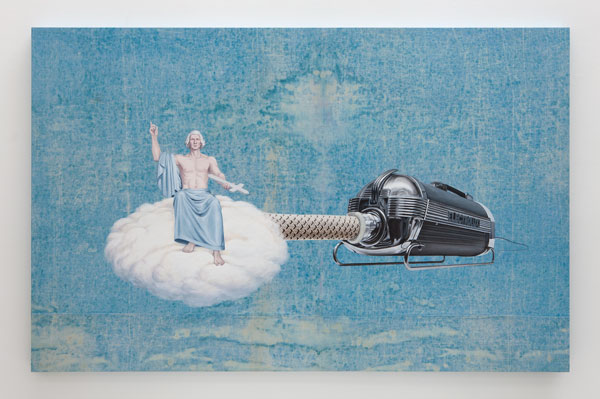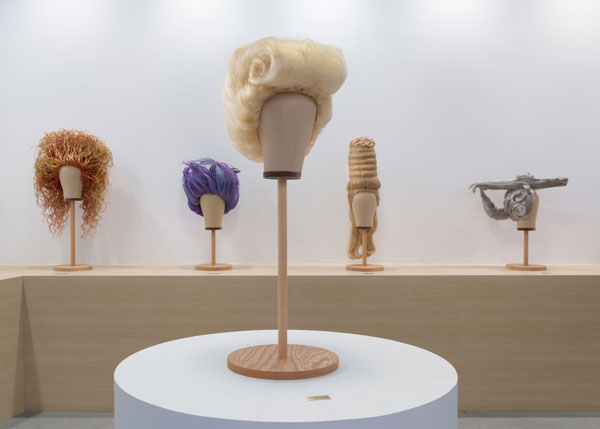In his short video Tales from the Wig Museum (2017), on view at Blum & Poe gallery, Jim Shaw appropriates the style of the opening narration from Rod Serling’s television series The Twilight Zone. In this piece, a wig-wearing narrator delights in relating alluring anecdotes about individual wigs that can be seen in Shaw’s installation at the newly opened Maurice and Paul Marciano Art Foundation (MAF). The black-and-white video makes a nice conceptual bridge between the two exhibitions as it clearly articulates and encapsulates Shaw’s keen wit and ironic sensibility.
At MAF, in the Millard Sheets-designed 1961 Scottish Rite Masonic Temple that has been transformed into a contemporary art museum by wHY’s Kulapat Yantrasast, Shaw manages to fill the expansive ground floor gallery space—a feat that showcases his seemingly limitless imagination. His witty and fascinating museum-within-a-museum—the site specific installation The Wig Museum—creates an immersive journey through altered Masonic backdrops, suspended cutouts, animations and a smattering of framed drawings.
That Shaw also had enough new work for a concurrent gallery exhibition is unfathomable, yet true. Unique to the gallery exhibit are a new series—Shaw’s quasi-anamorphic “Chaos” paintings (although they closely resemble a projected animation at MAF). These stylistically illustrative, black-and-white acrylic works are painted assemblages of invented and appropriated imagery depicting cartoony characters, explosions and exaggerated brushstroke-like gestures spiraling within and across the compositions. While Blum & Poe leverages the show at MAF by offering interrelated works as sale items, the gallery exhibition offers an intimate viewing experience, and it is rewarding to be able to gaze at isolated elements—distilled from the much larger backdrops—presented as small-scale pencil drawings or modest-sized paintings.

The Ascension of George Washington, 2017, courtesy of the artist and Blum & Poe, Los Angeles/New York/Tokyo
While Shaw’s video may be a teaser to visit the The Wig Museum, many of the paintings and drawings at the gallery connect to works exhibited at MAF. For example, Sibyl (an image that conflates the flying nun and Michelangelo’s Delphic Sibyl) and The Placing of the Stone of Folly, a work that depicts Steve Jobs inserting an iPhone into the head of Lex Luthor (both 2017), appear in both exhibitions. At the gallery, these works are small-scaled acrylic on muslin paintings whereas at MAF, they are large-scale freestanding black-and-white cut-outs positioned like props in Shaw’s 3D environment.
Using found Masonic backdrops and their history as a point of departure, Shaw creates an immersive experience in MAF’s spacious galleries where viewers travel through artworks that reflect the subconscious workings of his mind. One weaves through disparate large-scale paintings that reference pop culture, global media, politics and conspiracy theory simultaneously. Shaw makes surprising connections between the personal and the universal, presented as both fact and fiction. From within the labyrinthine space, The Wig Museum can be entered from different directions. The initial allure is toward Shaw’s actual Wig Museum where a red-and-white illuminated sign beckons. Inside are fantastically styled and wildly colored wigs, each with its own fascinating history. Completing the tableau, just outside his Wig Museum, Shaw creates a faux street with an ambling couple pushing a baby carriage past the façade of a jewelry shop. This façade is a translucent scrim dividing the space and directing viewers into the mystery that exists beyond. Think Twilight Zone again, which Shaw alludes to but never clearly states what will happen next.
Viewers traverse spot-lit darkened corridors filled with illustrated 2D cut-out panels either suspended from the ceiling or placed on the ground like stage props. Toward the back of the space is one of Shaw’s denouements: the ascension of a robed George Washington posed as Jesus and holding a cross, seated on a floating cloud. He is connected to a gigantic suspended vacuum cleaner whose cutout front and back parts bisect the figure. Emanating from the crotch, the long front hose sucks up shadowy figures near the floor while the back of the Electrolux expels his waste up near the ceiling. This work is both nasty and extremely humorous. In Shaw’s world, these elements coexist and inform each other. He is deadpan, serious and acutely aware of the present as well as the past. The Wig Museum as a cohesive installation can be compared to a ride at an amusement park where viewers travel through a curated journey: bombarded with provocative sights, at the journey’s end, they are left to process the experience. Shaw’s installation leaves one wanting to begin again, as upon each successive viewing more can be extracted.


